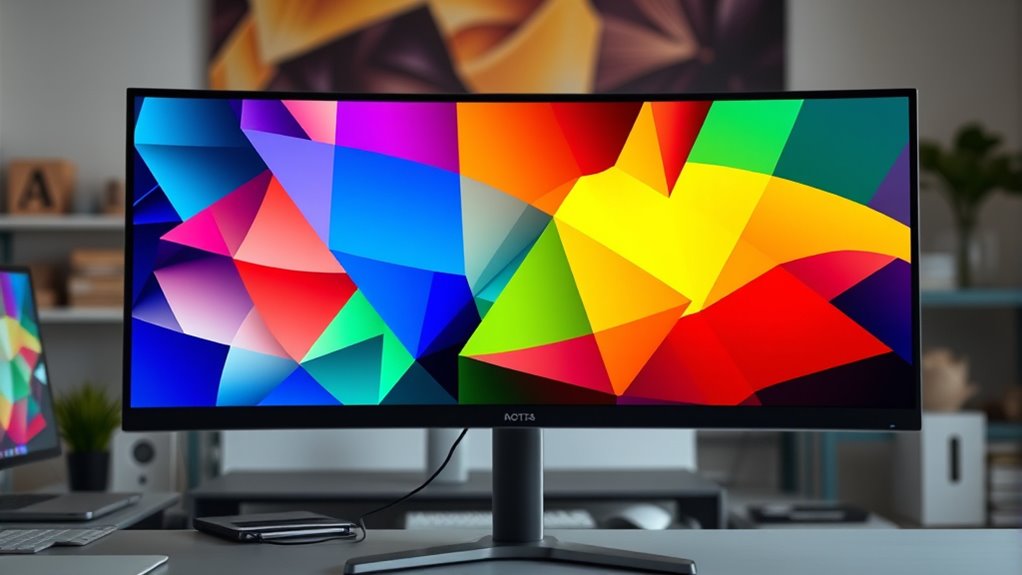Understanding color gamut and wide-gamut displays helps you see how screens reproduce richer, more vibrant colors. A display’s color gamut defines the range of colors it can show, with wide-gamut versions covering more shades for better accuracy and realism. Recognizing these differences helps you choose the right screen for tasks like photo editing or digital art. If you’re curious about how this technology impacts your viewing experience, you’ll find more insights ahead.
Key Takeaways
- Color gamut defines the range of colors a display can reproduce, affecting vibrancy and accuracy.
- Wide-gamut displays cover a larger color spectrum (like Adobe RGB, DCI-P3), offering more vivid and true-to-life visuals.
- Technologies supporting wide-gamut displays improve color depth, realism, and gradient smoothness.
- Proper calibration ensures accurate color reproduction and prevents dull or oversaturated images.
- Understanding a display’s color space coverage helps in selecting the right device for digital art, photography, and professional editing.
What Is Color Gamut and Why It Matters
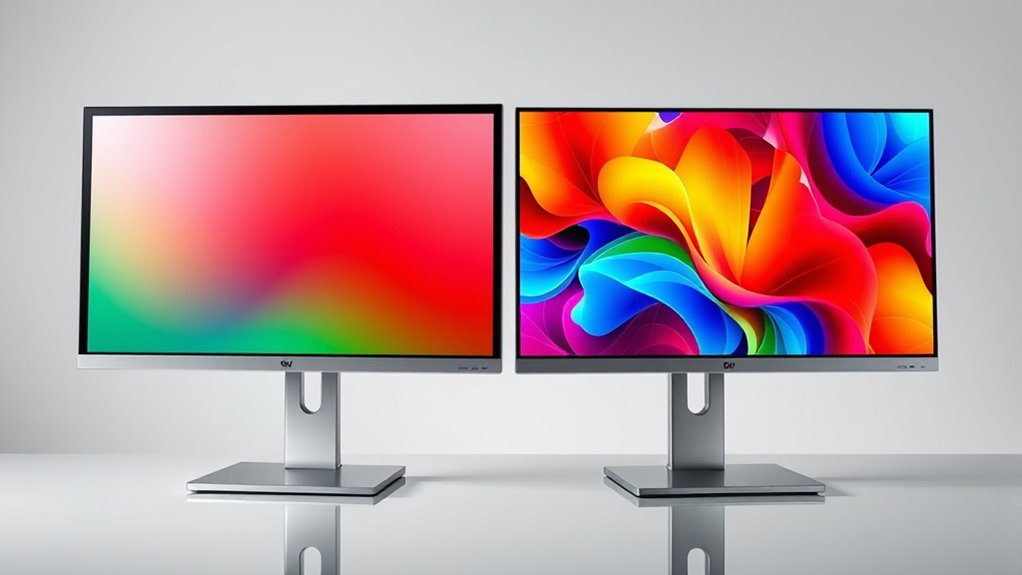
Understanding color gamut is essential because it defines the range of colors a display can reproduce. Your color perception depends heavily on the display’s gamut, influencing how vibrant and true-to-life images appear. When you work with digital art or photos, a wider color gamut allows you to explore more shades and nuances, enhancing your artistic expression. If your display has a limited gamut, colors may look dull or washed out, restricting your creative options. Recognizing the importance of color gamut helps you choose screens that accurately represent colors, ensuring your work looks consistent across different devices. A broader color gamut also plays a crucial role in image quality and visual fidelity, making your viewing experience more immersive and accurate. Understanding wide-gamut displays is particularly important as they are increasingly used in professional visual work. When selecting a display, considering the color space it covers can significantly impact your ability to produce and enjoy vibrant visuals. Additionally, being aware of color rendering standards can help you assess how well a display reproduces specific color ranges, which is vital for color-critical tasks. Incorporating knowledge of color management techniques can further optimize how colors are displayed across various devices. Ultimately, a broader color gamut empowers you to create and view images with richer, more vivid colors, elevating your visual experience.
Standard vs. Wide‑Gamut Displays: Key Differences
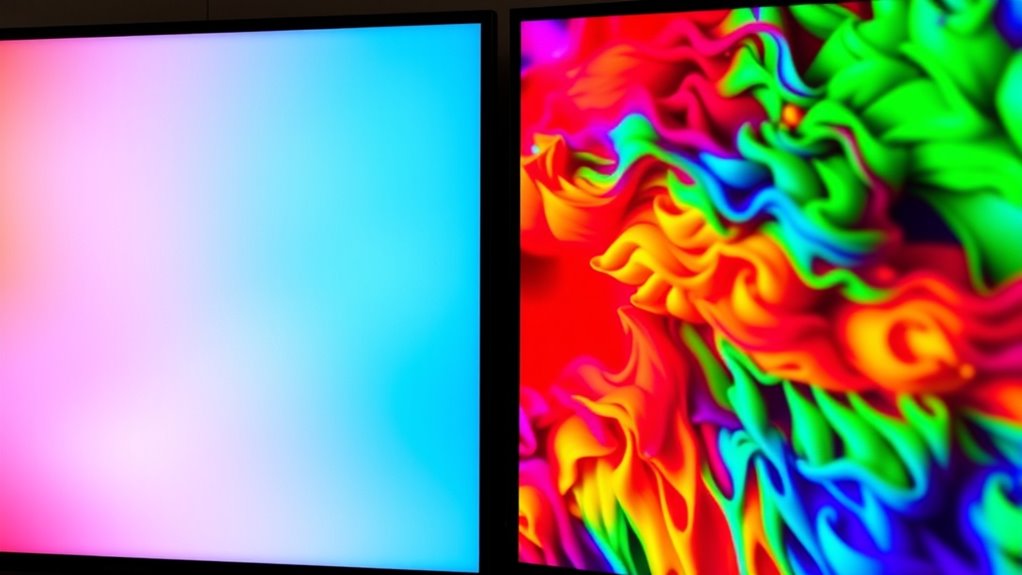
You’ll notice that wide-gamut displays can show a broader range of colors compared to standard ones. This expanded color range allows for more accurate and vibrant color representation. Understanding these differences helps you choose the right display for your specific needs. Additionally, color accuracy is crucial for tasks like digital art and photo editing, where precise color reproduction is essential. Recognizing how creative practice benefits from accurate color display can improve the quality of your work and enhance your creative process. Moreover, the wide color gamut is supported by advanced display technologies that ensure consistent and vivid visuals across different content types. Understanding the color gamut can help you appreciate the technological advancements behind high-quality displays. As technology progresses, display standards continue to evolve, offering even greater color precision and depth.
Color Range Variability
Standard displays typically cover a smaller portion of the color spectrum, resulting in limited color variety and less vibrant images. This narrower gamut causes color saturation to be subdued, making images appear duller. Gamut compression occurs when colors outside the display’s color range are mapped into its available spectrum, reducing vibrancy. The limitations of standard displays can be especially noticeable in professional photo editing and digital art. When selecting a display, understanding color spectrum limits is essential to ensure accurate and vivid color reproduction. A clear understanding of color accuracy can help in choosing the right display for creative work. Wide-gamut displays, however, expand this range, offering richer, more vivid colors. The table below highlights key differences: Understanding color spectrum limits can help in selecting the right display for your needs. Additionally, advancements in display technology continue to improve color fidelity and range.
Accurate Color Representation
When it comes to accurate color reproduction, the type of display you choose makes a significant difference. Standard displays often have limited color gamuts, which can affect your perception of true colors. Wide-gamut displays, on the other hand, offer a broader color range, making images appear more vivid and lifelike. Proper color calibration is essential to guarantee your display accurately represents colors, reducing discrepancies and enhancing color perception. Without calibration, even wide-gamut screens might show inaccurate hues. If precision matters—whether for photography, design, or video editing—you’ll benefit from a display that’s calibrated correctly. This ensures consistent, true-to-life colors across your workflow and viewing experience, giving you confidence that what you see is a faithful representation of the original content. Additionally, understanding color accuracy is crucial for achieving precise color reproduction in professional work. Achieving true color fidelity also depends on monitor calibration, which aligns the display settings with industry standards. Proper calibration can also help prevent color discrepancies caused by hardware variations or aging screens, ensuring ongoing accuracy. Regularly updating calibration helps maintain color consistency over time. Furthermore, cultural perceptions of color can influence how colors are interpreted across different audiences, emphasizing the importance of accurate reproduction in a global context.
Color Spaces: The Foundation of Digital Color Representation
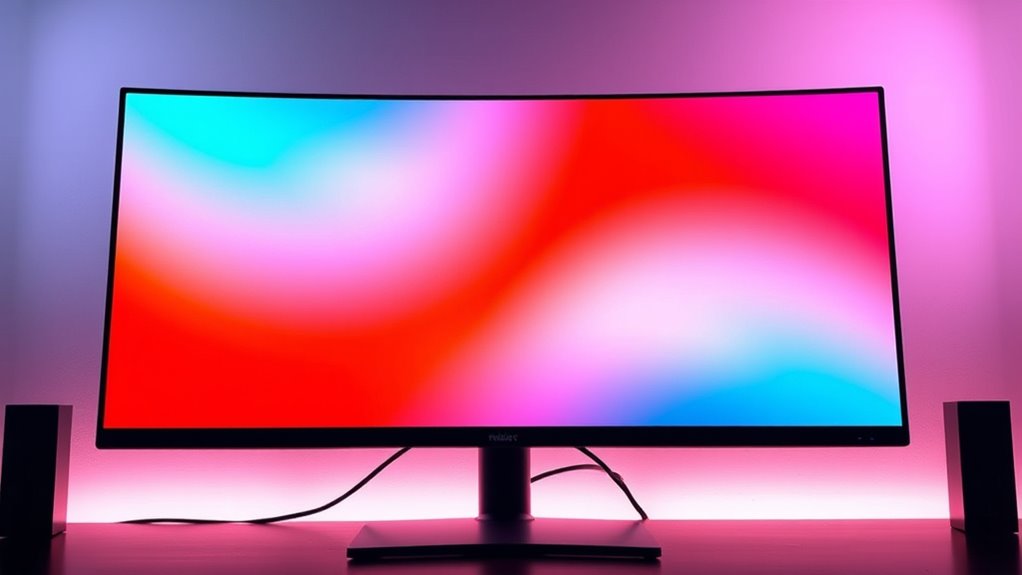
You rely on color spaces to accurately represent digital images, but not all are created equal. Standard color models like sRGB and Adobe RGB differ in their gamuts, affecting how colors appear across devices. Understanding these differences helps you choose the right color space for your projects. Additionally, awareness of display technologies such as wide-gamut displays can enhance color accuracy and vibrancy in your work. Recognizing the color gamut of your display ensures that you can better match your intended color output, especially when working with high-fidelity visuals. Moreover, some displays now incorporate Glycolic Acid benefits, which, although primarily skincare ingredients, serve as a metaphor for how certain technologies exfoliate and improve visual clarity. As cyber threats evolve, implementing AI security solutions can be crucial to safeguarding your digital assets and maintaining visual integrity across platforms.
Standard Color Models
Have you ever wondered how digital devices consistently display the same colors? Standard color models, like RGB and CMYK, serve as the foundation for digital color representation. These models define how colors are created and reproduced across devices, aiding in accurate color matching and calibration. Understanding these models helps guarantee consistency from screens to printers. For example, RGB works with light emitted by screens, while CMYK is used for printing. Different models prioritize different color ranges, so knowing their limitations is vital. Here’s a quick comparison: color space
| Model | Primary Use | Color Range | Color Matching | Calibration Focus |
|---|---|---|---|---|
| RGB | Digital displays | Wide | Device-dependent | Brightness, gamma |
| CMYK | Printing | Narrow | Material-dependent | Ink density |
Color Space Differences
Color spaces form the essential framework that determines how digital devices interpret and display colors. Variations in color space, known as color space variations, can cause perceptual color differences between devices or media. For example, some color spaces prioritize a wide range of colors, while others focus on perceptual accuracy. These differences impact how images appear across screens, printers, and cameras. When switching between color spaces, you might notice shifts in hue, saturation, or brightness, which can affect the consistency of your visual experience. Understanding these differences helps you choose the right color space for your project, ensuring that colors remain true to your intentions. Recognizing the perceptual color differences caused by color space variations is key to maintaining color fidelity across various digital and print platforms.
Benefits of Wide‑Gamut Technology in Visual Quality

What makes wide-gamut technology stand out in visual quality is its ability to display a broader range of colors, resulting in images that are more vibrant and true to life. With this technology, you’ll notice richer, more vivid colors that enhance your viewing experience. This means photos and videos appear more detailed and realistic, creating a deeper connection to what you’re watching or creating. The expanded color palette also reduces color banding and gradients look smoother, adding to the immersive experience. Whether you’re editing images or enjoying movies, wide-gamut displays deliver superior color accuracy and depth. This heightened color richness draws you into the content more fully, making your visual interactions more engaging and satisfying.
How to Recognize and Choose Wide‑Gamut Displays
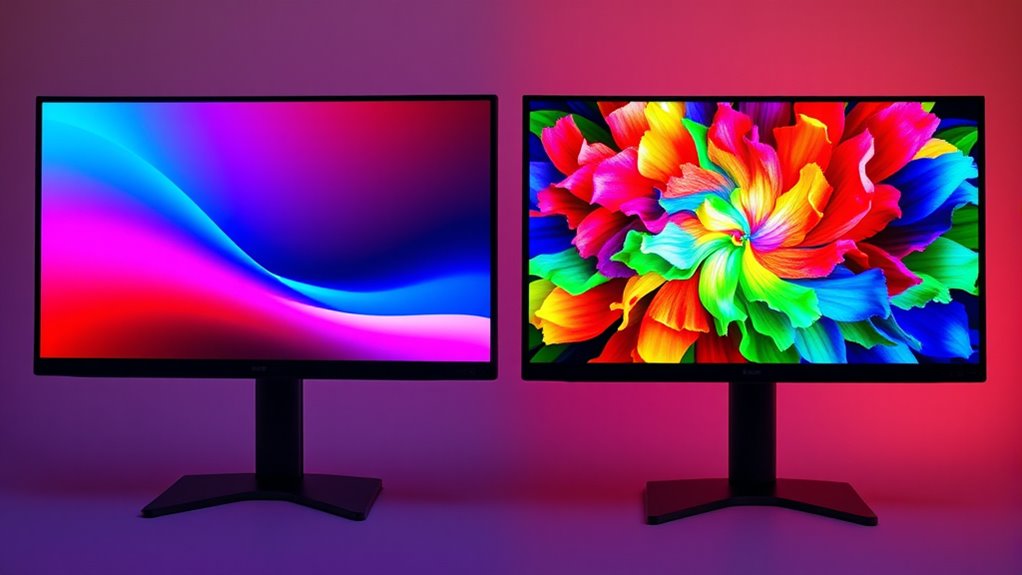
To recognize and choose a wide-gamut display, start by checking its specifications for color space coverage, like Adobe RGB or DCI-P3. These metrics indicate the range of colors the screen can reproduce. Look for displays with high coverage percentages in these color spaces for richer, more accurate colors. Additionally, consider the display’s color calibration, as factory presets can affect initial color accuracy. A good wide-gamut monitor should offer reliable calibration options to fine-tune colors to your needs. Keep in mind that a higher color space coverage doesn’t guarantee perfect performance without proper calibration. When selecting, prioritize models with factory presets optimized for color accuracy, but be prepared to calibrate further for the best results. This ensures vibrant visuals aligned with professional standards.
The Future of Color Reproduction in Display Technology

Advancements in display technology are rapidly transforming how you experience visual content, promising even more vibrant and accurate reproductions of colors. The future of color reproduction will focus on improving color calibration techniques to guarantee consistent, precise displays across devices. As technology progresses, you’ll notice enhanced wide-gamut displays that better match real-world colors, boosting viewer perception and immersion. Key developments include:
Future displays will offer more accurate, vibrant colors through advanced calibration and innovative materials.
- AI-driven color calibration for personalized viewing experiences.
- New materials enabling broader color gamuts with higher accuracy.
- Adaptive displays that adjust color output based on ambient lighting and viewer preferences.
These innovations will make your viewing experience more lifelike, with vivid colors that stay true to the original content, regardless of the device or environment.
Frequently Asked Questions
How Does Color Gamut Impact Gaming and Multimedia Experiences?
Color gamut plays a vital role in your gaming and multimedia experiences by enhancing color accuracy and visual immersion. When the color range is wider, you see more vibrant and true-to-life colors, making scenes more realistic and engaging. This improved color reproduction helps you notice details and depth, drawing you deeper into the experience. Ultimately, a broader color gamut delivers richer visuals, making your games and multimedia content more immersive and enjoyable.
Can Wide-Gamut Displays Cause Color Inconsistencies Across Devices?
Wide-gamut displays can cause color inconsistencies across devices if you don’t guarantee proper calibration. They offer a broader color range, but without correct calibration, colors may look different on other screens, affecting color accuracy. To avoid this, you need to calibrate each device regularly, ensuring consistent color reproduction. This helps maintain uniformity in your multimedia and gaming experiences, preventing unexpected color discrepancies and preserving visual fidelity across multiple devices.
Are There Any Health Concerns With Extended Exposure to Wide-Gamut Screens?
Some believe extended exposure to wide-gamut screens might cause health concerns, but current research shows no direct harm. You might experience eye strain or discomfort from prolonged blue light exposure, regardless of display type. To protect your eyes, use blue light filters and take regular breaks. While wide-gamut screens don’t pose unique health risks, staying mindful of eye strain helps maintain your eye health during long screen sessions.
How Do Different Industries Utilize Wide-Gamut Display Technology?
Different industries use wide-gamut display technology to enhance their work. You might use it for color grading in film production, ensuring vibrant, accurate visuals. In medical imaging, it helps you see detailed, precise images for better diagnoses. Wide-gamut screens allow you to work with a broader spectrum of colors, making your visuals more realistic and informative. This technology improves accuracy and quality across various fields, helping you achieve professional results.
What Are the Cost Implications of Upgrading to a Wide-Gamut Display?
Upgrading to a wide-gamut display involves a slight cost premium, but it’s often worth the investment for richer visuals. You might face some compatibility challenges with existing hardware or software, which could add to overall expenses. While the initial investment is higher, the enhanced color accuracy and broader range can elevate your work or entertainment experience, making it a valuable step despite the extra considerations.
Conclusion
Understanding color gamut and wide-gamut displays helps you appreciate the nuances of visual quality. While the technology offers richer, more vibrant images, it also invites you to explore beyond the ordinary. Embracing these advancements subtly encourages you to see the world with a slightly different perspective—one that hints at the endless possibilities of color. In doing so, you may find yourself more receptive to the beauty that surrounds you, waiting patiently to be discovered.
